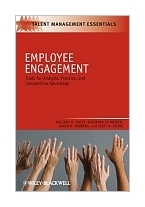|
||
• wydawnictwa polskie
• Zamów informacje o nowościach z wybranego tematu • kontakt
• Cookies na stronie |
EMPLOYEE ENGAGMENT: TOOLS FOR ANALYSIS PRACTICE AND COMPETITIVE ADVANTMACEY W.H. SCHNEIDER B. BARBERA K.M. YOUNG S.A.wydawnictwo: WILEY-BLACKWELL , rok wydania 2009, wydanie Icena netto: Employee Engagement: Tools for Analysis, Practice, and Competitive Advantage Providing both practical advice, tools, and case examples, Employee
Engagement translates best practices, ideas, and concepts into concrete and practical
steps that will change the level of engagement in any organization. Table of Contents Series Editor’s Preface Preface Acknowledgments 1. Engaging Engagement How Engagement Makes a Difference and What Engagement Is The Business Case for Employee Engagement Engagement as Psychic Energy: On the Inside Engagement as Behavioral Energy: How Engagement Looks to Others How an Engaged Workforce Creates Positive Financial Consequences for Organizations On High Performance Work Environments: Four Principles for Creating an Engaged Workforce The Capacity to Engage The Motivation to Engage The Freedom to Engage The Focus of Strategic Engagement Engagement and Discretionary Effort Interaction of Cause and Effect 2. The “Feel and Look” of Employee Engagement The Feel of Engagement Urgency Focus Intensity Enthusiasm Cross-Cultural Issues in Describing the Feelings of Engagement Summary: The Feel of Engagement The Look of Engagement: Employee Behavior Persistence Proactivity Role Expansion Adaptability Summary: The Look of Engagement Strategically Aligned Engagement Behavior On Commitment, Alignment, and Internalization What About Employee Satisfaction? Where Does This Take Us? 3. The Key to an Engaged Workforce: An Engagement Culture What is Organizational Culture? Creating a Culture for Engagement: How People are Valued in Organizations The Central Role of a Culture of Trust in Employee Engagement Trust in Senior Leadership, Trust in Management, and Trust in the System The Role of Fairness in a Culture of Engagement Culture Emergence Learning the Culture Do the People or the Environment Make the Culture? The Role of the Work Itself in a Culture of Engagement The Role of Monetary Incentives in a Culture of Engagement Does Organizational Success Impact Employee Engagement? The Role of Culture in Creating Strategic Employee Engagement How Culture Supports Alignment Summary 4. Phase 1 of Creating and Executing an Engagement Campaign: Diagnostics and the Engagement Survey Pre-Survey Diagnostic Activities Step 1: Conduct the Background Check and Acquire the “Language” Step 2: Engage Leadership to Define Strategic Engagement and the Supporting Culture Step 3: Craft the Engagement Messaging The Engagement Survey Writing Questions that Focus on the Feelings of Engagement Writing Questions that Focus on Behavioral Engagement Writing Generic Behavioral Engagement Survey Questions Writing Questions that Focus on Creating the Employee Capacity to Engage Writing Questions that Focus on Whether People Have a Reason to Engage Writing Questions that Focus on Whether People Feel “Free” to Engage Summary 5. Phase 2 of Creating and Executing an Engagement Campaign: Action Planning and Intervention Survey Results Interpretation Benchmarks Survey Results Feedback Feedback at the Executive Level Feedback at the Managerial Level Communicating Survey Results Company-Wide Summary Preparing the Organization for Taking Action Commitment for Action Resources and Tools That Facilitate Action Planning and Change Variants on the Action Planning Model How Much Measurable Change is Possible? Actual Changes That Build and Maintain Engagement Interventions that Build Confidence and Resiliency Interventions that Enhance Social Support Networks Interventions that Renew or Restore Employee Energy Interventions that Enhance the Motivation to Engage Interventions that Enhance the Freedom to Engage Interventions Focused on Process Fairness Interventions Focused on Outcome Fairness Interventions Focused on Interactional Fairness Leadership Behavior and Engagement Summary 6. Burnout and Disengagement: The Dark Side of Engagement Disengagement: Early Unmet Expectations at Work The Nature and Trajectory of Burnout The Components of Burnout The Trajectory of Burnout Is Burnout Inevitable? Effective Coping With Burnout Social Support Autonomy and Job Control Burnout, Workaholism, and Engagement: Resolution of the Paradox Job Creep and the Erosion of Trust Additional Stress Factors and Disengagement Remedies and Interventions The Need for Recovery Other Interventions Resistance to Change and Engagement: Another Dark Side of Engagement How Should Engagement Initiatives be Communicated? Conclusion 7. Talking Points: Introducing or Rethinking Engagement in Your Organization Notes Subject Index Author and Name Index 228 pages, Paperback Księgarnia nie działa. Nie odpowiadamy na pytania i nie realizujemy zamówien. Do odwolania !. |


